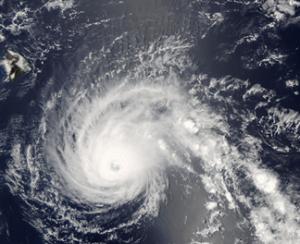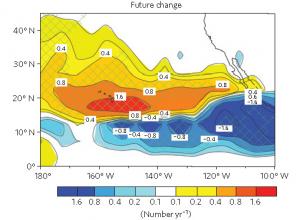Scientists study possible increase of hurricanes in Hawai'i
University of Hawaiʻi at MānoaNews of a hurricane threat sends our hearts racing, glues us to the Internet for updates, and makes us rush to the store to stock up on staples. Hawaiʻi, fortunately, has been largely free from these violent storms in the recent past, only two having made landfall in more than 30 years.
Now a study headed by a team of scientists at the International Pacific Research Center at the University of Hawaiʻi at Mānoa, shows that Hawaiʻi could see a two- or three-fold increase in tropical cyclones by the last quarter of this century. The study, which appeared in the May 5, 2013, online issue of Nature Climate Change, though, leaves open the question, how worried Island residents should get.
“Computer models run with global warming scenarios generally project a decrease in tropical cyclones worldwide. This, though, may not be what will happen with local communities,” said lead author Hiroyuki Murakami.
To determine whether tropical cyclones will become more frequent in Hawaiʻi with climate change, Murakami and climate expert Bin Wang at the University of Hawai'i at Mānoa Meteorology Department joined forces with Akio Kitoh at the Meteorological Research Institute and the University of Tsukuba in Japan. The scientists compared in a state-of-the-art, high-resolution global climate model the recent history of tropical cyclones in the North Pacific with a future (2075–2099) scenario, under which greenhouse gas emissions continue to rise, resulting in temperatures about 2°C higher than today.
“In our study, we looked at all tropical cyclones, which range in intensity from tropical storms to full-blown category 5 hurricanes. From 1979 to 2003, both observational records and our model document that only every four years on average did a tropical cyclone come near Hawaiʻi. Our projections for the end of this century show a two-to-three-fold increase for this region,” explained Murakami.
The main factors responsible for the increase are changes in the large-scale moisture conditions, the flow patterns in the wind, and in surface temperature patterns stemming from global warming.
Most hurricanes that might threaten Hawaiʻi now are born in the eastern Pacific, south of the Baja California Peninsula. From June through November the ingredients there are just right for tropical cyclone formation, with warm ocean temperatures, lots of moisture, and weak vertical wind shear. But during the storms’ long journey across the 3000 miles to Hawaiʻi, they usually fizzle out due to dry conditions over the subtropical central Pacific and the wind shear from the westerly subtropical jet.
Surprisingly, even though fewer tropical cyclones will form in the eastern Pacific in Murakami’s future scenario, we can expect more of them to make their way to Hawaiʻi.
The upper-level westerly subtropical jet will move poleward so that the mean steering flow becomes easterly. Thus, storms from Baja California are much more likely to make it to Hawaiʻi. Furthermore, since the climate models also project that the equatorial central Pacific will heat up, conditions may become more favorable for hurricane formation in the open ocean to the south or southeast of Hawaiʻi.
“Our finding that more tropical cyclones will approach Hawaiʻi as Earth continues to warm is fairly robust because we ran our experiments with different model versions and under varying conditions. The yearly number we project, however, still remains very low,” reassured study co-author Wang.
Citation:
Hiroyuki Murakami, BinWang, Tim Li, and Akio Kitoh: Projected increase in tropical cyclones near Hawaiʻi. Nature Climate Change, May 5, 2013, on line publication: http://dx.doi.org/10.1038/NCLIMATE1890
Funding:
This work was conducted under the framework of the `Projection of the Change in Future Weather Extremes Using Super-High-Resolution Atmospheric Models' supported by the KAKUSHIN and SOUSEI programmes of the Ministry of Education, Culture, Sports, Science and Technology (MEXT) of Japan. H.M. was supported by the `Research on Prediction of Climate and Environmental Change to Contribute to Mitigation Plan Decision Against Climate Change' of the MRI of Japan. B.W. acknowledges the support from the Global Research Laboratory (GRL) Program of the Korean Ministry of Education, Science and Technology (MEST, 2011-0021927). Calculations were performed on the Earth Simulator.


